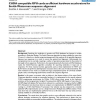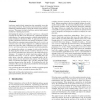76 search results - page 9 / 16 » Redundancy in Instruction Sequences of Computer Programs |
ISCA
2000
IEEE
13 years 12 months ago
2000
IEEE
Smaller feature sizes, reduced voltage levels, higher transistor counts, and reduced noise margins make future generations of microprocessors increasingly prone to transient hardw...
ASPLOS
2008
ACM
13 years 9 months ago
2008
ACM
Many code analysis techniques for optimization, debugging, or parallelization need to perform runtime disambiguation of sets of addresses. Such operations can be supported efficie...
BMCBI
2008
13 years 7 months ago
2008
Background: Searching for similarities in protein and DNA databases has become a routine procedure in Molecular Biology. The Smith-Waterman algorithm has been available for more t...
PLDI
1999
ACM
13 years 11 months ago
1999
ACM
Load-reuse analysis finds instructions that repeatedly access the same memory location. This location can be promoted to a register, eliminating redundant loads by reusing the re...
BMCBI
2008
13 years 7 months ago
2008
Background: Ornithine decarboxylase antizymes are proteins which negatively regulate cellular polyamine levels via their affects on polyamine synthesis and cellular uptake. In vir...


